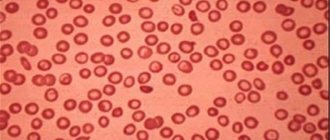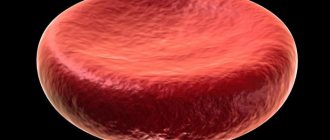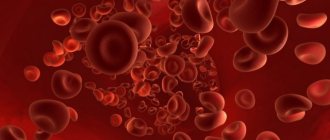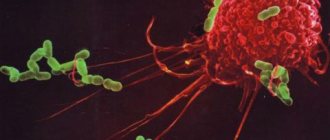The formed elements of blood represent a wide variety of specific structures of the body responsible for certain functions. In more detail, we are talking about a number of cytological units.
In total there are three large groups:
- Leukocytes. White blood cells. Responsible for the normal immune response. They act as a kind of protectors of the body. They work as a defensive force. There are several more subtypes of these cytological structures, but that’s a completely different conversation.
- Platelets. Red blood platelets. Perform several important functions. The key, if described superficially, is to quickly close the wound areas. They form a special plug that prevents blood from leaking out. There are other tasks, but they are secondary.
- Red blood cells. Red blood cells (RBC). They ensure normal gas exchange due to the fact that they are able to attach and transport oxygen and carbon dioxide. Without them there can be no normal life.
If the red blood cells in the blood are elevated, this may indicate infectious and inflammatory processes, disorders of the bone marrow, endocrine disorders, oncology and other diseases, that is, it is basically a sign of a pathological process. But not always.
We need to look into this in more detail.
Etiology
An increased content of red blood cells in the blood is defined as when the level of red blood cells is very different from the permissible values. It is worth noting that the norm depends on factors such as a person’s gender and age category.
| Age | Normal (10^12 cells per liter of blood) |
| Newborns | 3.6-6.6 |
| 1 month | 3-5.4 |
| 2-4 months | 2.7-4.9 |
| 5 months-2 years | 3.4-5.2 |
| From 3 to 6 years | 3.9-5.3 |
| From 7 to 12 years | 4-5.2 |
| Boys | 4.5-5.3 |
| Girls | 4.1-5.1 |
| Men | 3.9-5.5 |
| Women | 3.5-4.7 |
As mentioned above, the increase in red blood cells is influenced by the course of a limited range of diseases, which include:
- disruption of the functioning of the respiratory system;
- congenital or acquired heart defects;
- Pickwick's syndrome;
- erythremia;
- chronic leukemia;
- various acute infectious diseases;
- oncological processes;
- Aerz's disease;
- diseases leading to increased blood viscosity;
- pulmonary failure;
- vascular pathologies;
- any type of anemia;
- problems in the functioning of the bone marrow;
- malignant hypertension;
- extensive burns;
- chronic gastrointestinal diseases, such as gastritis or ulcers;
- diabetes.
However, the high content of red blood cells in the body is not always a consequence of one of the pathological processes described above. Physiological reasons are presented:
- drinking large amounts of chlorinated water or sugary carbonated drinks;
- living in mountainous areas with thin air;
- frequent mental or physical fatigue;
- prolonged exposure to stressful situations;
- emotional instability;
- poor nutrition, which is why a person does not receive enough vitamins;
- professional sports;
- food poisoning, which often results in profuse vomiting and diarrhea;
- long-term addiction to smoking cigarettes, and this factor can be attributed even to infants (passive smoking).
It is very important to remember that elevated red blood cells in the blood can be inherited from parents.
Structure and functions of red blood cells
The role of red blood cells in the blood
Red blood cells are round, biconcave red blood cells that contain hemoglobin, fats and protein. This composition provides basic and additional functions of the cell. The main purpose of red blood cells is oxygen-carbon dioxide exchange. The hemoglobin contained in the cell allows oxygen to be transported from the lungs to all tissues and carbon dioxide to be introduced from them.
Additional purpose of red blood cells:
- deliver nutrients (vitamins, amino acids and glucose) necessary for normal cell functioning;
- protect cells from the effects of radicals and toxins (they destroy cells and interfere with their normal functioning) and promote their removal from the body;
- help maintain immunity;
- regulate metabolic processes and maintain acid-base balance;
- maintain blood viscosity and participate in the formation of clots (a function necessary when a vessel is injured, to prevent loss of large amounts of blood);
- maintain the elasticity and strength of blood vessels.
Red blood cells are necessary for the normal functioning of the body, as they maintain balance in all metabolic processes. A change in their concentration in the blood leads to a malfunction of all organs. Red blood cells are formed in the bone marrow, and after 4 months they are destroyed in the spleen and liver.
Symptoms
When the distribution width of red blood cells is increased, some clinical manifestations may be expressed. However, they are nonspecific, which is why they cannot indicate the course of this particular disorder with 100% accuracy.
The main symptoms are:
- redness of the skin, especially on the face;
- slight but rather unpleasant skin itching;
- increase in blood tone indicators;
- nasal hemorrhages;
- hepatosplenomegaly;
- decreased visual acuity;
- periodic dizziness;
- attacks of severe headache;
- decreased ability to work;
- lethargy and weakness;
- decreased appetite;
- muscle and joint pain;
- dyspnea;
- tinnitus.
Such symptoms of elevated red blood cells in women, men and children will be complemented by clinical manifestations that are most characteristic of a particular pathological etiological factor.
How is the analysis performed?
The number of red blood cells is determined during a general blood test. For this purpose, a Goryaev chamber consisting of cells is used. In most cases, biological material is taken from the patient's finger. To collect capillary blood, a disposable, sterile scarifier for puncturing the skin, cotton swabs with alcohol and a capillary in the form of a glass tube are used.
The skin of the woman’s ring finger is treated with an antiseptic, after which a 2-3 mm puncture is made. The first drop of blood is not taken for examination, but is removed with a cotton swab. Then the test tube is filled and the biological material is sent to the laboratory for analysis. Less commonly, blood is taken from a vein for a general blood test.
To count the number of red blood cells, blood can be diluted with sodium chloride solution. Before analysis, you need to rinse the Goryaev chamber and dry it thoroughly. A cover glass should be placed on the area of the chamber with the mesh. A drop of the test material is placed in front of the slit. Blood must fill the cells without outside help. Before microscopy, it is recommended to wait 1-2 minutes to allow all red blood cells to settle.
Cell counting is performed at low magnification. Red blood cells are counted in 5 large squares. The number of small squares is 80. The results are recorded in quantitative terms per unit volume of blood (1 l). This takes into account the preliminary dilution of the blood. Not everyone knows the optimal content of red blood cells, the norm in women and the reasons for possible deviations.
Important information: What do increased segmented or band neutrophils in the child’s blood indicate?
Diagnostics
The level of red blood cells in the blood is determined during a general clinical study of the main biological fluid of the human body. For such laboratory diagnostics, both capillary and venous biological material may be needed.
It must be taken into account that patients should prepare for such an analysis, namely, completely stop eating food at least 4 hours before such a procedure. If a person does not do this, then most likely the results will be interpreted incorrectly by the hematologist, which may require repeat blood donation.
However, the data obtained during this method of diagnosis cannot show which particular pathology or physiological factor was the impetus for the development of such a disorder. In order for a doctor to find the root cause, a person needs to undergo a comprehensive examination.
Primary diagnostics, common to all, combines:
- examination by the clinician of the medical history;
- collection and analysis of life or family history to identify the influence of physiological sources or genetic predisposition;
- palpation of the anterior wall of the abdominal cavity - this is how hepatosplenomegaly is detected;
- measurement of blood tone and heart rate values;
- a detailed survey of the patient - this will enable the doctor to draw up a complete symptomatic picture, which sometimes accurately indicates the provoking disease.
In addition, patients may be prescribed:
- specific laboratory tests;
- instrumental procedures, including endoscopic;
- consultations with specialists from various fields of medicine.
When should you consult a doctor?
If changes in the level of red blood cells do not bring any changes in well-being, then there is no need to worry. If you experience increased fatigue, drowsiness, wetness of the skin, dizziness, the identified symptoms are noted for the first time, you need to contact your local physician.
Typically, the clinical picture of the disease appears when indicators are significantly higher or lower than normal.
If such a condition has previously occurred, and the patient knows about his disease and is being treated by a certain specialist in this regard, then you can directly seek medical help from this specialist (oncologist for a malignant neoplasm, cardiologist for pathology of the cardiovascular system).
If you receive injuries accompanied by heavy bleeding, you should remember that all blood counts will drop and therefore it is important to call emergency medical help as quickly as possible.
Treatment
What to do if red blood cells are elevated
If during the diagnosis it is confirmed that a person’s red blood cells are elevated, then treatment of the underlying pathology begins first. Treatment tactics are selected individually and can be:
- conservative;
- surgical – operations are performed open or laparoscopically;
- complex.
However, regardless of the sources of the increase in red blood cells in the blood of men, women or children, the level of red blood cells can be normalized with the help of:
- taking medications - very often this is limited to the use of vitamin-mineral complexes;
- transfusion of red blood cells;
- adherence to a therapeutic diet;
- use of alternative methods of therapy.
In such situations, the following products are required for daily consumption:
- dietary meats;
- seafood;
- hot red pepper;
- fermented milk products;
- legumes;
- raw vegetables;
- cottage cheese;
- garlic and tomatoes;
- melon and citrus fruits;
- cherries and sweet cherries;
- bell pepper;
- green tea and other blood thinning products.
A complete list of approved food components can only be provided by the attending physician.
After the approval of the clinician, it is allowed to prepare decoctions and infusions at home, based on:
- bitter wormwood;
- sweet clover;
- dandelion roots;
- shepherd's purse;
- horsetail;
- mistletoe;
- dried cranberries.
These are just the basic rules of treatment - the treatment regimen is drawn up individually for each person.
Reasons for the decline
The decrease in the number of red cells can be absolute and relative. In absolute cases, they are not synthesized by the body in the required quantities due to the disease or their level decreases due to bleeding. A relative (false) decrease occurs during blood thinning, for example, during pregnancy. Common causes of decreased red blood cells in women:
- leukemia;
- liver and kidney diseases;
- parasitic diseases;
- sepsis;
- lymphogranulomatosis;
- previous surgical operations;
- AIDS;
- autoimmune diseases;
- destruction of red cells (hemolysis), due to transfusion of an incompatible blood group, malignant cell tumors, DIC syndrome;
- viral infections (pneumonia, syphilis, toxoplasmosis, influenza, malaria);
- increased processes of cell destruction in the red bone marrow;
- anemia (iron deficiency, B12 deficiency, posthemorrhagic, hemolytic);
- bleeding (internal, external);
- enlarged spleen;
- diseases of the gastrointestinal tract;
- endocrine pathologies;
- alcoholism;
- paraneoplastic syndrome.
The number of red cells decreases with a deficiency of vitamins, protein, iron, with heavy physical activity (for example, exhausting sports), as well as with hereditary diseases of the circulatory system (ovalocytosis, microspherocytosis) and long-term use of antibiotics.
Important! The level of red blood cells in women decreases when the menstrual cycle is disrupted - prolonged and heavy bleeding.
Prevention and prognosis
To prevent an adult or child from having problems with elevated red blood cells, you need to follow several simple preventive rules, including:
- lifelong cessation of bad habits;
- complete and balanced nutrition;
- constant strengthening of the immune system;
- drinking only purified water;
- avoiding physical, emotional and mental fatigue;
- taking medications strictly as prescribed by the clinician;
- eating quality foods.
It is also very important to conduct a full examination of the body in the clinic several times a year, undergoing the necessary laboratory and instrumental procedures and visiting all specialists. This will make it possible to identify any of the pathological sources early.
As for the prognosis, the increased content of red blood cells does not pose a threat to human life. However, we should not forget about the danger of the sources of this condition - each provoking disease has a number of its own complications.
Mean erythrocyte volume (MCV): what is it, norm and deviations, reasons for increase and decrease
© Z. Nelly Vladimirovna, laboratory diagnostics doctor at the Research Institute of Transfusiology and Medical Biotechnology, especially for SosudInfo.ru (about the authors)
Erythrocyte index MCV (mean corpuscular volume), indicating the average volume of red blood cells (erythrocytes), expressed in femtoliters (fl) or cubic microns (µm2), is recognized as an independent value that is fully capable of characterizing the entire population of red blood cells.
The abbreviation MCV entered the lexicon of laboratory service specialists and hematologists with the advent of automatic hematology analyzers, capable of accurately calculating the values of this indicator in a short time, following the program embedded in them and without involving laboratory staff in the work process.
The values of the average volume of erythrocytes may be of interest to specialists involved in the diagnosis and treatment of various types of anemic conditions.
On the other hand, the questions and concerns of patients are understandable, in whose general blood test such a parameter occurs and shows some deviations from the generally accepted norm (what can it mean if the MCV level is increased or decreased, how does this threaten health?).
One of the main advantages of the hematology analyzer
Before the advent of automatic hematological analyzers, indicators such as the diameter of red blood cells, their volume, and hemoglobin saturation of erythrocytes were determined for the most part visually during a morphological examination of blood smears, therefore such a parameter as MCV or the average Er volume was usually not included in the blood test. Modern methods, based on the capabilities of hematological analyzers that are capable of characterizing red blood cells with a volume of 30 to 300 fL, involve measuring the volume of a single red cell and use the results obtained to calculate the average value of red blood cell volume, that is, MCV.
Automated systems, successfully solving such problems, enable doctors to obtain complete, but previously inaccessible, information about the characteristics of blood cellular elements.
One of the important indicators for diagnosing and distinguishing between different types of anemia is the quantitative expression of the average volume of erythrocytes or MCV (as this parameter is indicated in the general blood test form).
The MCV calculation performed by an automatic analyzer is considered to be a more sensitive component of the hemogram than a visual analysis of the diameter of red blood cells; in accuracy it is much superior to the results of a microscopic examination of a smear (an increase in Ø Er by 5% corresponds to an increase in cell volume by 15%).
The average volume of erythrocytes is used for the differential diagnosis of anemia also because the diameter has the ability to change its value under the influence of physiological factors, for example, at the end of the working day the average value of the diameter increases noticeably, and at night, on the contrary, it decreases and by 8 o’clock in the morning shows its minimum values.
In addition, physical stress has an impact on the size of red blood cells.
To ensure that these factors do not interfere with obtaining objective research results, a blood sample placed in the analyzer is diluted with a special stabilizing solution, which ensures the accuracy of the measurement of MCV and other erythrocyte indices, leveling out visual artifacts.
graphs of distribution of red blood cells by volume and their interpretation
By the way, you can calculate the average volume Er using the formula:
- MCV = [Ht,% x 10] /
However, it becomes possible to make these calculations manually if the hematocrit indicator (Ht,%) is known - the ratio of red blood cells to the total blood volume, and the content of red blood cells (RBC), but here you don’t have to worry or find it difficult - the hemogram can also determine these parameters automatic hematology system. In a word, a “smart” machine can free a person from unnecessary routine... So why then make calculations using formulas if the analyzer provides a ready-made result? After this, would the doctor better analyze the study, taking into account the quantitative values of the indicators issued by the device? This is true, however, there are a number of conditions when the doctor will have to return to the microscope to study the morphology and measure the diameter of red blood cells, which we will discuss below (in the section “Not without nuances”).
The norm for MCV is a relative concept
This value is measured in cubic microns (µm2) or femtoliters (fl), where 1 µm2 = 1 fl.
The MCV norm is in the range of 80 x 1015/l - 100 x 1015/l or 80 - 100 femtoliters. Meanwhile, the concept of “norm” for this parameter is very relative, because, characterizing a red blood cell as a normocyte, MCV classifies the anemic state as normocytic anemia, but does not at all exclude pathology in general.
The MCV value “more than 100 fL” is interpreted as an increased level and characterizes the erythrocyte as a macrocyte, and the average volume, not reaching 80 fL, is taken as a reduced value - such MCV indicators are characteristic of microcytes.
The average volume of red blood cells tends to change only in the first days and months of life, then the values of the indicator are established almost in a strict range (the difference between the upper and lower limit is very small), so we can say that MCV indicators show extreme stability in healthy people throughout life. Meanwhile, depending on gender and age, there are still some deviations in values from generally accepted norms: 80 – 100 fl (table):
Age (days, weeks, years)MCV – mean erythrocyte volume, fl
| Women | Men | |
| Newborns 0 – 1 day | Up to 128 | Up to 128 |
| 1 week of life | Up to 100 | Up to 100 |
| Up to a year of life | 77 – 79 | 77 – 79 |
| 1 – 2 years | 72 – 89 | 70 – 90 |
| 36 years | 76 – 90 | 76 – 89 |
| 7 – 12 | 76 – 91 | 76 – 81 |
| 13 – 16 | 79 – 93 | 79 – 92 |
| 20 – 29 | 82 – 96 | 81 – 93 |
| 30 – 39 | 91 – 98 | 80 – 93 |
| 40 – 49 | 80 – 100 | 81 – 94 |
| 50 – 59 | 82 – 99 | 82 – 94 |
| 60 – 65 | 80 – 100 | 81 – 100 |
| Over 65 years old | 80 – 99 | 78 – 103 |
It should be noted that there is a direct relationship between the number of red blood cells and the MCV indicator, because the body tries to regulate the level of Er and the content of red pigment in them so that constancy is maintained, therefore, an increase in the content of red blood cells will be followed by a proportional decrease in their volume.
Increased mean red blood cell volume
We can talk about an increased volume of red blood cells (averaged values), and at the same time about megaloblastic and macrocytic anemia, if the MCV value has exceeded 100 fl. Similar values (MCV - increased) are characteristic of such pathological conditions as:
- Lack of vitamin B12 (isolated B12 deficiency anemia);
- Lack of folic acid (isolated folate deficiency anemia);
- Combined deficiency of vitamin B12 and folic acid (B12-folate deficiency anemia);
- Myelodysplastic syndromes;
- Some hemolytic anemias;
- Separate pathology of the liver.
Reduced red blood cell volume
A reduced red blood cell volume (meaning the average value) implies microcytic anemia and occurs if the MCV is reduced, that is, its level has fallen below 80 fL, which happens when:
The average volume is normal, but the disease develops...
MCV values in the range of 80 – 100 fL indicate normocytic anemia, which can be observed in the case of:
- Aplastic anemia;
- Some hemolytic anemias;
- Regenerative phase of iron deficiency anemia;
- Anemic conditions after blood loss;
- Myelodysplastic syndrome.
Not without nuances
Everything is good and wonderful, but in practice there are conditions when MCV is falsely increased, decreased, or is within normal values.
An increased volume of red blood cells can be caused by:
- Cold autoagglutination (to eliminate this factor, the sample should be kept at a temperature of +37ºС in a thermostat);
- Diabetic ketoacidosis (plasma hyperosmolarity causes a rapid increase in the volume of red blood cells and, accordingly, macrospherocytosis when the blood is exposed to the analyzer solution during dilution).
We must not forget that a reduced MCV indicator does not always reflect the true picture of the blood, for example, with consumption coagulopathies or with mechanical damage to red blood cells with destruction and subsequent hemolysis, the MCV will be reduced (this effect is ensured by fragments of red cells present in the blood).
Approximately the same thing happens with the norm.
Severe anisocytosis, as a rule, causes the presence of cells of different populations in the blood (both microcytes - reduced volume, and macrocytes - increased volume), while leaving the average volume of erythrocytes within the normal range. And in this case, without taking into account the RDW indicator, it is hardly possible to come to the correct diagnosis.
anisocytosis - the presence of red blood cells in the blood with a clear pathological variation in volume (while the average volume may be normal)
Another example is microspherocytic hemolytic anemia.
The erythrocytes (microspherocytes) present in the peripheral blood have a diameter noticeably lower than expected, but the average volume of erythrocytes does not react to such changes in any way and is within normal values.
This is where you will have to remember the morphological study of the smear using optical instruments and measure the diameter of the red blood cells, that is, the machine (no matter how smart it is) will not yet replace the doctor’s eyes and hands.
Correlation of MCV with other erythrocyte indices
MCV values correlate with other erythrocyte indices:
- MCH - it is measured in picograms (pg) and denotes the average content of red blood pigment (hemoglobin - Hb) in a red blood cell, this index has a correlative relationship with MCHC (average concentration of Hb in Er) and with MCV - an indicator indicating the average volume of red cells;
- MCHC - its value is expressed in grams per deciliter (g/dl), this index characterizes the average concentration of Hb in the red blood cell, it correlates with MCH (average Hb content in Er) and with MCV, that is, with the index described in this work .
These indicators are also calculated by an automatic hematology analyzing system, although all this can be done manually if you first determine the number of red blood cells (RBC), hemoglobin level (HB) and hematocrit (Ht). And all this is done in the analyzer... Thus:
- MCH = [Hb, (g/dl) x 10] /
- MCHC = [Hb, (g/dl) x 100] / [Ht,%]
It is obvious that erythrocyte indices have correlative relationships with each other, however, the MCH and MCHC indices are not as often used to determine the type of anemia as the average volume of erythrocytes, although, it should be noted, an increased level of MCH is observed in hyperchromic anemia (megaloblastic and accompanying cirrhosis of the liver). A reduced value of the indicator (MSI) is observed in hypochromic iron deficiency conditions and malignant tumor processes.
MSHC is usually reduced in hypochromic anemia (sideroblastic anemia, IDA), as well as thalassemia.
In addition, this erythrocyte index (meaning MCV) is often used as a supplement to another indicator characterizing the state of red blood cells - RDW or the degree of anisocytosis of erythrocytes. Together they help to make a differential diagnosis of microcytic anemias.
Display all posts with the tag:
Source: https://sosudinfo.ru/krov/mcv-srednij-obem-eritrocitov/











